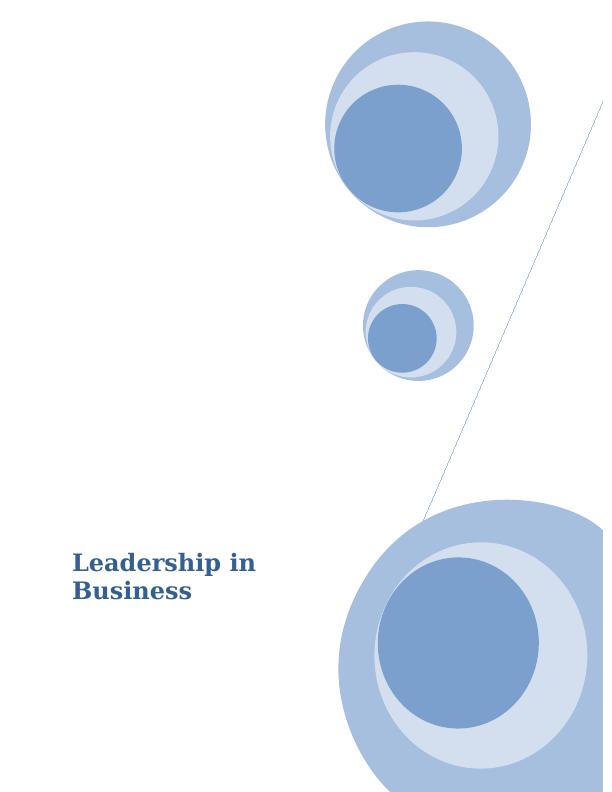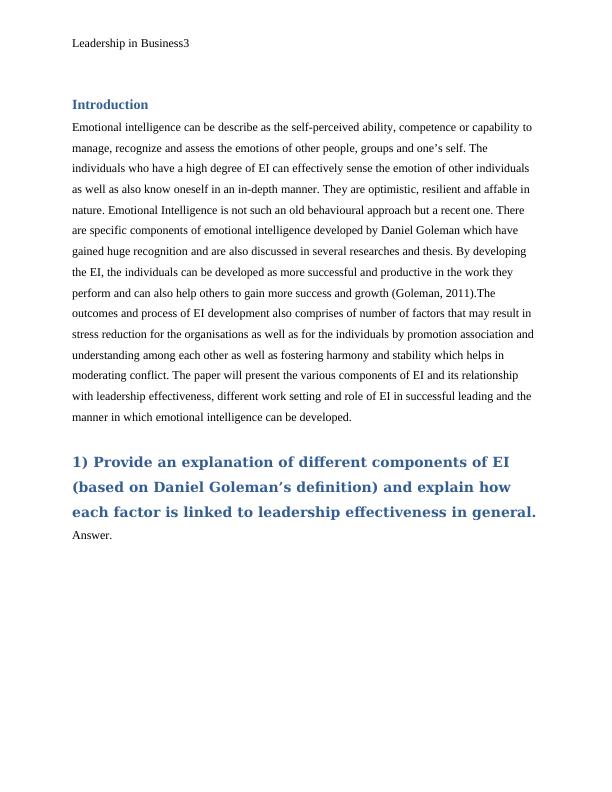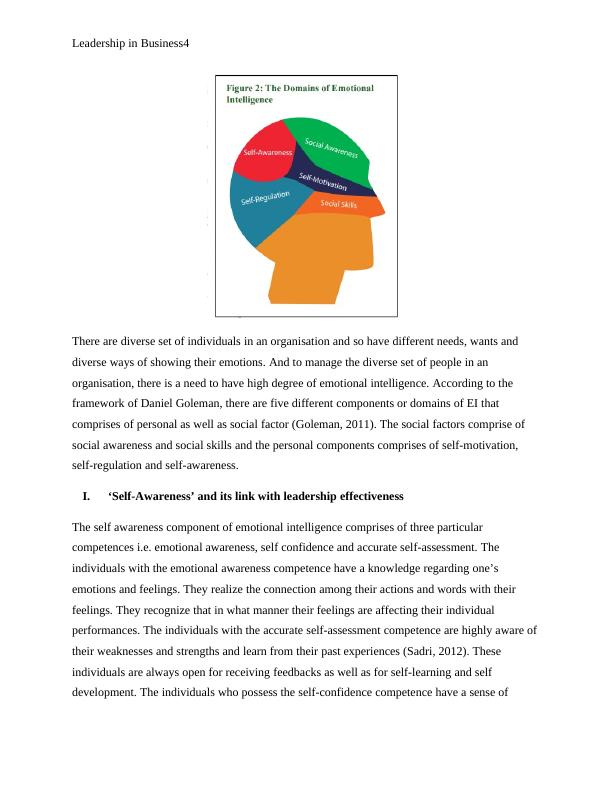Introduction to Leadership in Business
Added on 2020-05-01
14 Pages4388 Words59 Views
Leadership in
Business
Business

Leadership in Business2
Contents
Introduction......................................................................................................................................3
1) Provide an explanation of different components of EI (based on Daniel Goleman’s definition)
and explain how each factor is linked to leadership effectiveness in general.................................3
2) Pick any two work settings you want. Ideally, they should be very different from each other so
you can compare and contrast between the two. For each setting, discuss which components of
EI would be the most important for a leader to be successful.........................................................8
3) Can EI be taught or developed? If so, how?..............................................................................10
Conclusion.....................................................................................................................................11
References......................................................................................................................................13
Contents
Introduction......................................................................................................................................3
1) Provide an explanation of different components of EI (based on Daniel Goleman’s definition)
and explain how each factor is linked to leadership effectiveness in general.................................3
2) Pick any two work settings you want. Ideally, they should be very different from each other so
you can compare and contrast between the two. For each setting, discuss which components of
EI would be the most important for a leader to be successful.........................................................8
3) Can EI be taught or developed? If so, how?..............................................................................10
Conclusion.....................................................................................................................................11
References......................................................................................................................................13

Leadership in Business3
Introduction
Emotional intelligence can be describe as the self-perceived ability, competence or capability to
manage, recognize and assess the emotions of other people, groups and one’s self. The
individuals who have a high degree of EI can effectively sense the emotion of other individuals
as well as also know oneself in an in-depth manner. They are optimistic, resilient and affable in
nature. Emotional Intelligence is not such an old behavioural approach but a recent one. There
are specific components of emotional intelligence developed by Daniel Goleman which have
gained huge recognition and are also discussed in several researches and thesis. By developing
the EI, the individuals can be developed as more successful and productive in the work they
perform and can also help others to gain more success and growth (Goleman, 2011).The
outcomes and process of EI development also comprises of number of factors that may result in
stress reduction for the organisations as well as for the individuals by promotion association and
understanding among each other as well as fostering harmony and stability which helps in
moderating conflict. The paper will present the various components of EI and its relationship
with leadership effectiveness, different work setting and role of EI in successful leading and the
manner in which emotional intelligence can be developed.
1) Provide an explanation of different components of EI
(based on Daniel Goleman’s definition) and explain how
each factor is linked to leadership effectiveness in general.
Answer.
Introduction
Emotional intelligence can be describe as the self-perceived ability, competence or capability to
manage, recognize and assess the emotions of other people, groups and one’s self. The
individuals who have a high degree of EI can effectively sense the emotion of other individuals
as well as also know oneself in an in-depth manner. They are optimistic, resilient and affable in
nature. Emotional Intelligence is not such an old behavioural approach but a recent one. There
are specific components of emotional intelligence developed by Daniel Goleman which have
gained huge recognition and are also discussed in several researches and thesis. By developing
the EI, the individuals can be developed as more successful and productive in the work they
perform and can also help others to gain more success and growth (Goleman, 2011).The
outcomes and process of EI development also comprises of number of factors that may result in
stress reduction for the organisations as well as for the individuals by promotion association and
understanding among each other as well as fostering harmony and stability which helps in
moderating conflict. The paper will present the various components of EI and its relationship
with leadership effectiveness, different work setting and role of EI in successful leading and the
manner in which emotional intelligence can be developed.
1) Provide an explanation of different components of EI
(based on Daniel Goleman’s definition) and explain how
each factor is linked to leadership effectiveness in general.
Answer.

Leadership in Business4
There are diverse set of individuals in an organisation and so have different needs, wants and
diverse ways of showing their emotions. And to manage the diverse set of people in an
organisation, there is a need to have high degree of emotional intelligence. According to the
framework of Daniel Goleman, there are five different components or domains of EI that
comprises of personal as well as social factor (Goleman, 2011). The social factors comprise of
social awareness and social skills and the personal components comprises of self-motivation,
self-regulation and self-awareness.
I. ‘Self-Awareness’ and its link with leadership effectiveness
The self awareness component of emotional intelligence comprises of three particular
competences i.e. emotional awareness, self confidence and accurate self-assessment. The
individuals with the emotional awareness competence have a knowledge regarding one’s
emotions and feelings. They realize the connection among their actions and words with their
feelings. They recognize that in what manner their feelings are affecting their individual
performances. The individuals with the accurate self-assessment competence are highly aware of
their weaknesses and strengths and learn from their past experiences (Sadri, 2012). These
individuals are always open for receiving feedbacks as well as for self-learning and self
development. The individuals who possess the self-confidence competence have a sense of
There are diverse set of individuals in an organisation and so have different needs, wants and
diverse ways of showing their emotions. And to manage the diverse set of people in an
organisation, there is a need to have high degree of emotional intelligence. According to the
framework of Daniel Goleman, there are five different components or domains of EI that
comprises of personal as well as social factor (Goleman, 2011). The social factors comprise of
social awareness and social skills and the personal components comprises of self-motivation,
self-regulation and self-awareness.
I. ‘Self-Awareness’ and its link with leadership effectiveness
The self awareness component of emotional intelligence comprises of three particular
competences i.e. emotional awareness, self confidence and accurate self-assessment. The
individuals with the emotional awareness competence have a knowledge regarding one’s
emotions and feelings. They realize the connection among their actions and words with their
feelings. They recognize that in what manner their feelings are affecting their individual
performances. The individuals with the accurate self-assessment competence are highly aware of
their weaknesses and strengths and learn from their past experiences (Sadri, 2012). These
individuals are always open for receiving feedbacks as well as for self-learning and self
development. The individuals who possess the self-confidence competence have a sense of

End of preview
Want to access all the pages? Upload your documents or become a member.
Related Documents
Emotional Intelligence: Critical Analysis of Five Articleslg...
|18
|4049
|30
Emotional intelligence cultural intelligencelg...
|22
|1876
|11
Emotional Intelligence, Cultural Intelligence and Diversitylg...
|8
|2010
|52
Collaboration in Classroom Management | Reportlg...
|5
|1056
|57
COMMON WEALTH OF AUSTRALIAlg...
|19
|6241
|15
Emotional Intelligence, Cultural Intelligence & Diversitylg...
|15
|2715
|52
